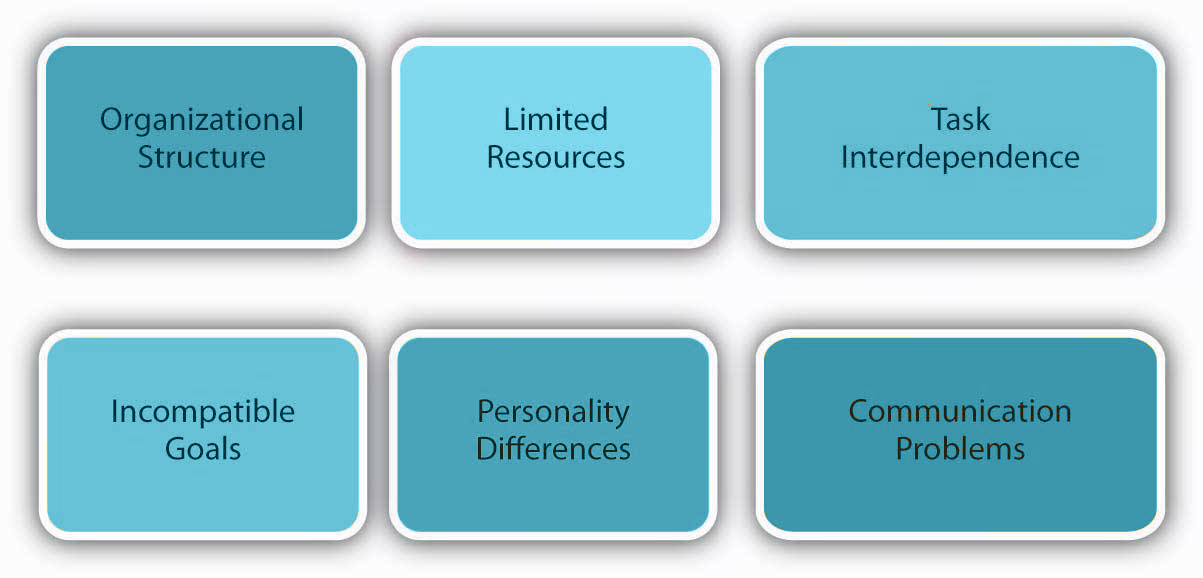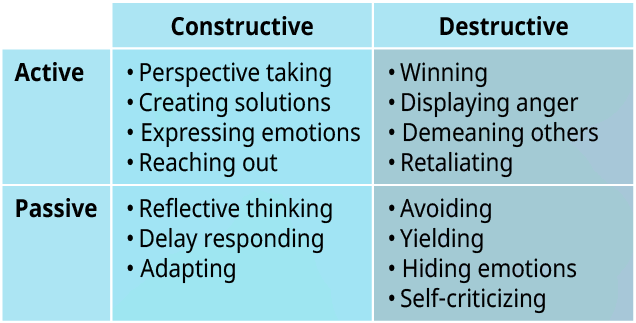1.3 Common Sources of and Response to Conflict in the Workplace
Common Sources of Conflict in the Workplace
Remember, anything that leads to a disagreement can be a cause of conflict. Although conflict is common to organizations, some organizations have more than others. A number of factors are known to facilitate organizational conflict (Miles, 1980). We’ll go over six common sources of workplace conflict. They are summarized in Figure 1.2 below.

Organizational Structure
Conflict tends to take different forms, depending upon the structure of an organization. For example, if a company uses a matrix structure as its organizational form, it will have decisional conflict built in because the structure specifies that each manager report to two bosses. For example, global company ABB Inc. is organized around a matrix structure based on the dimensions of country and industry. This structure can lead to confusion as the company is divided geographically into 1,200 different units and by industry into 50 different units. Conflict can also emerge from jurisdictional ambiguities—situations where it is unclear exactly where responsibility for something lies. For example, many organizations use an employee selection procedure in which applicants are evaluated both by the personnel department and by the department in which the applicant would actually work. Because both departments are involved in the hiring process, what happens when one department wants to hire an individual, but the other department does not?
A second factor is status inconsistencies among the parties involved. For example, managers in many organizations have the prerogative to take personal time off during workdays to run errands, and so forth, whereas non-managerial personnel do not. Consider the effects this can have on the non-managers’ view of organizational policies and fairness.
Differences in performance criteria and reward systems provide more potential for organizational conflict. This often occurs because of a lack of common performance standards among differing groups within the same organization. For example, production personnel are often rewarded for their efficiency, and this efficiency is facilitated by the long-term production of a few products. Sales departments, on the other hand, are rewarded for their short-term response to market changes—often at the expense of long-term production efficiency. In such situations, conflict arises as each unit attempts to meet its own performance criteria.
Consider This: Organizational Structure
 Precarity and Conflict
Precarity and Conflict
Given neoliberal tendencies and the erosion of secure employment across many industries, the realities of the workplaces today are such that precarious employment situations are increasingly more common (Woodcock & Graham, 2020). This might resemble short-term contracts and other such contingent ‘gig-economy’ arrangements that equates to wage and job insecurity (see Woodcock & Graham, 2020). Gig economy work may include delivery work, microwork, online freelancing, or domestic and care work (Woodcock & Graham, 2020). Beyond the gig-economy, precarity is also prevalent in creative industries (Chafe & Kaida, 2020). Further, even professions that might not typically be associated with precarity (such as post-secondary education and library and information science) often rely heavily on contract and part-time workers (see Babb, 2021; Lacey, 2019; Curtis et al., 2016). Given the prevalence across a multitude of sectors, the implications can be numerous and widespread.
Precarity can be bound up with various levels of conflict and other challenges at work and beyond (Chafe & Kaida, 2020; Fan et al., 2019). Lacey (2019) discusses financial insecurity, devaluation of labour, and challenges around mental and physical health. Further, Babb (2021) describes the “sickly sense of insecurity” and the “omni-present low-level sense of dread” that comes along with precarity (p. 3). The job circumstances of precarious employment make it such that speaking out against the organization/institution, discipline, or employer can be quite risky (Ahmed, 2021; Babb, 2021). Moreover, in the workplace, it is not uncommon for precariously employed workers to work alongside permanent fulltime colleagues who have job-security, higher pay, and benefits (see Curtis, et al., 2016). Yet, the structural disadvantages that come along with precarity can play a significant role in one’s ability to engage with conflict even laterally (e.g. it may be harder to be assertive, or to speak up in the first place when there is an issue, etc.). Crucially, precariously employed workers have a greater likelihood of being from equity-deserving groups, which can add additional layers to existing challenges and inequities (Levac & Cowper-Smith, 2016). Thus, consideration of power dynamics in conflict is ever more crucial.
Still, Woodcock and Graham (2020) discuss various challenges that workers face in the gig economy, alongside creative ways workers have organized to push back against poor conditions (e.g. strikes and other coordinated labour actions, undermining surveillance attempts, challenging independent contractor status). Sometimes precarious work, such as online freelancing, is structured in a way that isolates workers from each other; nonetheless, workers find ways to access support, community, and solidarity (e.g. in other online spaces, such as forums or other social media) (Woodcock & Graham, 2020). Further, Ahmed (2021) discusses complaint collectives as a mode of communal agency and resistance. Workers show agency and innovation in adapting to challenges in the workplace landscape; however, how much resilience, vulnerability, and strife should a worker have to demonstrate to have gainful employment?
Questions to Consider
- What levels of conflict can you identify in this discussion on power differentials and precarity?
- What roles and responsibilities do you think employers should play in preventing some of the issues discussed?
Limited Resources/Common Resource Pool
Another previously discussed factor that contributes to conflict is dependence on common resource pools. Resources such as money, time, and equipment are often scarce (or they are perceived to be scarce). Competition among people or departments for limited resources is a frequent cause for conflict. For example, cutting-edge laptops and gadgets such as the newest iPhone are expensive resources that may be allocated to employees on a need-to-have basis in some companies. When a group of employees have access to such resources while others do not, conflict may arise among employees or between employees and management. While technical employees may feel that these devices are crucial to their productivity, employees with customer contact such as sales representatives may make the point that these devices are important for them to make a good impression to clients. Because important resources are often limited, this is one source of conflict many companies have to live with. When resources are limited, a zero-sum game exists in which someone wins and, invariably, someone loses.
Task Interdependence
Another cause of conflict is task interdependence; that is, when accomplishment of your goal requires reliance on others to perform their tasks the greater the extent of task interdependence among individuals or groups (that is, the more they have to work together or collaborate to accomplish a goal), the greater the likelihood of conflict if different expectations or goals exist among entities, in part because the interdependence makes avoiding the conflict more difficult. This occurs in part because high task interdependency heightens the intensity of relationships. Hence, a small disagreement can very quickly get blown up into a major issue.
For example, if you’re tasked with creating advertising for your product, you’re dependent on the creative team to design the words and layout, the photographer or videographer to create the visuals, the media buyer to purchase the advertising space, and so on. The completion of your goal (airing or publishing your ad) is dependent on others.
Incompatible Goals
Sometimes conflict arises when two parties think that their goals are mutually exclusive. Within an organization, incompatible goals often arise because of the different ways department managers are compensated. For example, a sales manager’s bonus may be tied to how many sales are made for the company. As a result, the individual might be tempted to offer customers “freebies” such as expedited delivery in order to make the sale. In contrast, a transportation manager’s compensation may be based on how much money the company saves on transit. In this case, the goal might be to eliminate expedited delivery because it adds expense. The two will butt heads until the company resolves the conflict by changing the compensation scheme.
Personality Differences
Personality differences among coworkers are common. By understanding some fundamental differences among the way people think and act, we can better understand how others see the world. Knowing that these differences are natural and normal lets us anticipate and mitigate interpersonal conflict – it’s often not about “you” but simply a different way of seeing and behaving. For example, Type A individuals have been found to have more conflicts with their coworkers than Type B individuals.
In addition to personality, a variety of individual differences, such as personal abilities, traits, and skills, can influence in no small way the nature of interpersonal relations. Individual dominance, aggressiveness, authoritarianism, and tolerance for ambiguity all seem to influence how an individual deals with potential conflict. Indeed, such characteristics may determine whether or not conflict is created at all.
Communication Problems
Various communication problems or ambiguities in the communication process can create a breeding ground for conflict. When one person misunderstands a message or when information is withheld, the person often responds with frustration and anger. Sometimes conflict arises simply out of a small, unintentional communication problem, such as lost emails or dealing with people who don’t return phone calls. Giving feedback is also a case in which the best intentions can quickly escalate into a conflict situation.
Now that we’ve identified common sources of conflict, let’s turn our attention to responses to conflict.
Responses to Conflict
There are many possible responses to conflict that we will explore throughout this book. Some of these strategies try to end the conflict, conflict resolution, while other strategies merely seek to minimize the negative effects of a conflict on a on team performance, conflict management. We will learn more about resolution and conflict management strategies throughout this book, the focus will be on conflict management strategies and how we, as individuals, can make positive contributions to the workplace by managing our thoughts, feelings, and behaviours.
There are a variety of individual responses to conflict that you may see as a team member. Some people take the constructive and thoughtful path when conflicts arise, while others may jump immediately to destructive behaviors. In Managing Conflict Dynamics: A Practical Approach, Capobianco et al. (2005) recognized that there are both constructive and destructive responses to conflict, as well as active and passive responses that we need to recognize. In the event of conflict, the goal is to have a constructive response in order to encourage dialogue, learning, and resolution (Capobianco et al., 2005). Responses such as perspective taking, creating solutions, expressing emotions, and reaching out are considered active and constructive responses to conflict. Reflective thinking, delay responding, and adapting are considered passive and constructive responses to conflict. See Figure 1.3 for a visual of the constructive responses, as well as the destructive responses, to conflict.

Let’s Review
 In summary, conflict is never easy for an individual or a team to navigate through, but it can and should be done. Illuminating the team about areas of conflict and differing perspectives can have a very positive impact on the growth and future performance of the team, and it should be managed constructively.
In summary, conflict is never easy for an individual or a team to navigate through, but it can and should be done. Illuminating the team about areas of conflict and differing perspectives can have a very positive impact on the growth and future performance of the team, and it should be managed constructively.
Adapted Works
“Handle Conflict and Negotiation” in Human Resources Management – Canadian Edition by Stéphane Brutus and Nora Baronian is licensed under a Creative Commons Attribution-NonCommercial-ShareAlike 4.0 International License, except where otherwise noted.
“Conflict and Negotiations” in Organizational Behaviour by OpenStax is licensed under a Creative Commons Attribution 4.0 International License.
“Opportunities and Challenges to Team Building” in Principles of Management by OpenStax is licensed under a Creative Commons Attribution 4.0 International License, except where otherwise noted.
References
Ahmed, S. (2021). Complaint!. Duke University Press.
Babb, M. (2021). A reflection on precarity. Partnership: The Canadian Journal of Library and Information Practice and Research, 16(2), 1–5.
Capobianco, S., Davis, M., & Kraus, L. (2005). Managing conflict dynamics: A practical approach. Eckerd College.
Chafe, D., & Kaida, L. (2020). Harmonic dissonance: Coping with employment precarity among professional musicians in St John’s, Canada. Work, Employment and Society, 34(3), 407–423. https://doi.org/10.1177/0950017019865877
Curtis, J. W., Mahabir, C., & Vitullo, M. W. (2016). Sociology faculty members employed part-time in community colleges: Structural disadvantage, cultural devaluation, and faculty-student relationships. Teaching Sociology, 44(4), 270-286. https://doi.org/10.1177/0092055X16654744
Fan, W., Lam, J., & Moen, P. (2019). Stress proliferation? Precarity and work–family conflict at the intersection of gender and household income. Journal of Family Issues, 40(18), 2751–2773. https://doi.org/10.1177/0192513X19862847
Lacey, S. (2019). Job precarity, contract work, and self-care. Partnership: The Canadian Journal of Library and Information Practice and Research, 14(1), 1-8. https://doi.org/10.0.82.91/partnership.v14i1.5212
Levac, L. & Cowper-Smith, Y. (2016). Women and public sector precarity: Causes, conditions, and consequences. Canadian Research Institute for the Advancement of Women. https://www.criaw-icref.ca/wp-content/uploads/2021/04/Women-and-Public-Sector-Precarity-Causes-Conditions-and-Consequences.pdf
Miles, R. (1980). Macro organizational behaviour. Scott Foresman.
Woodcock, J. & Graham, M. (2020). The gig economy: A critical introduction. Polity.

